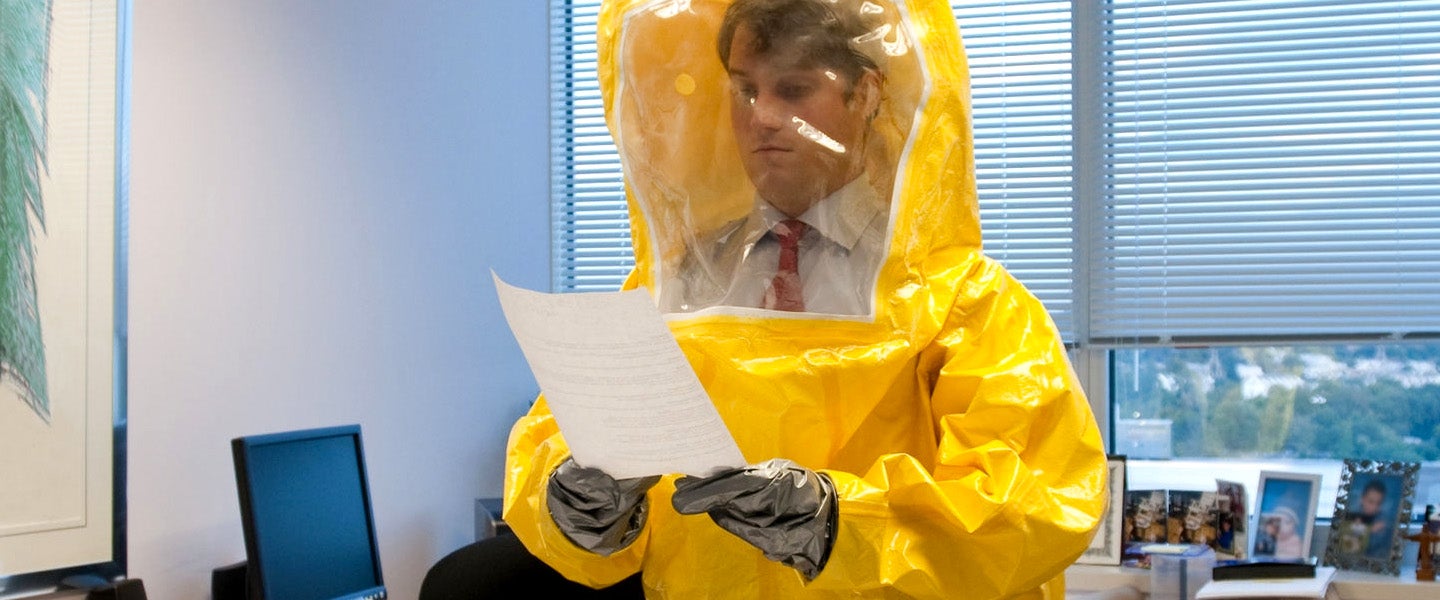The World Health Organization has officially classified the coronavirus, or COVID-19, as a pandemic, plunging the human race ever further into an abysmal sense of panic and trepidation. As a result, many people are taking what they believe to be necessary precautions: Teaching themselves to stop touching their faces, staying home from work and… dressing up in full hazmat suits?
Yeah, supermodel Naomi Campbell and some other random dude recently made the news for traversing airports while dressed in hazmat suits, and comedian Howie Mandel was seen walking the streets in one. Campbell even stopped for a doomsday-inspired photo shoot in the middle of LAX (and as an aside, hazmat suit stocks are way up right now).
Sure, Campbell, Mandel and this other man might seem to be taking extreme — and perhaps even absurd — measures to avoid contact with the coronavirus, but things are only getting worse, and hey, maybe hazmat suits really are the key to escaping infection. Then again…
What do hazmat suits even do, anyway?
Hazmat suits come in an assortment of shapes and sizes, some of which are higher up on the anti-disaster scale than others. But essentially, hazmat suits act as a barrier, formed by plastic, fabric and rubber, along with an independent source of oxygen. Simpler suits can be slipped on to protect against, say, some kind of dangerous liquid, whereas more advanced variations can become completely airtight to defend against airborne contaminants and toxic chemicals — which is what we’d want in the current coronavirus scenario. Naturally, Campbell was wearing an extremely simple one, paired with a measly surgical mask, which means she was basically wasting her time with the whole getup (but at least she got that sweet Instagram pic).
The fancy ones might work, huh? How much are they?
Erhm, a quick Google search pulled one up for more than $700, another one for about $1,000 and another for almost $3,500. So, not cheap.
Damn. But it would definitely work?
Well, not 100 percent. See, like similar viruses, the coronavirus is believed to spread through droplets produced when an infected person coughs or sneezes (or even breathes, really), which then make their way into the mouths, noses and sometimes even eyes of nearby people. Simply inhaling the droplets into your lungs can result in infection, too. Of course, an airtight suit and a personal supply of oxygen would prevent these droplets from getting inside of you, however, now your hazmat suit is covered in COVID-19 germs, and you have virtually no way out.
This is an important consideration, since hazmat suits only work when you also follow appropriate hazmat procedures, which often means employing a series of sterile rooms where you can safely change out of your hazardous suit, a process that often requires the careful help of another person in another hazmat suit and all kinds of expensive equipment.
In other words, actual hazmat crews have lengthy, thoughtful decontamination procedures, and casually donning a hazmat suit becomes completely ineffective if you carelessly expose yourself to the coronavirus the second you start taking it off.
So hazmat suits are worthless against the coronavirus?
No! In fact, professionals are already using hazmat suits to help thwart the spread of the coronavirus. I briefly spoke with Jordan Darrow, of Lakeland Industries, a global manufacturer of protective clothing, and while he emphasized that the company would rather not engage in interviews about the coronavirus, he did point me toward a few of their products that would be of “use in coronavirus applications,” adding that “sealed-seam constructed products” would be especially important for preventing any kind of viral breech. But again, you need to know exactly how to use these products for them to work appropriately, otherwise it’s just a waste of time and money.
What the hell am I supposed to do, then?
As the Centers for Disease Control and Prevention have said, wash your hands, clean any frequently touched surfaces in your home and stay away from anyone who might have the coronavirus. A hazmat suit might help you accomplish that last bit, but if you have no professional training, it will mostly just make you look like a big, broke doofus.

